Nalewka — traditional Polish spice, herb and fruit liqueurs
Polish liqueurs called 'nalewka' (singular) or 'nalewki' (plural) in original, are alcoholic extracts from fruit, spices, flowers or herbs. Usually Polish nalewka contains 40-45 per cent of alcohol just like vodka does. However, according to many Polish people nalewka tastes much better and is equally popular both amongst men, as well as women. Fruit liqueurs are always drunk from little glasses and often served as an addition to spicy meals or dinners. The Old Polish tradition claims that medium-dry and semi-sweet fruit liqueurs nalewka should be served with meat dishes, while sweet nalewka is a dessert alcohol.
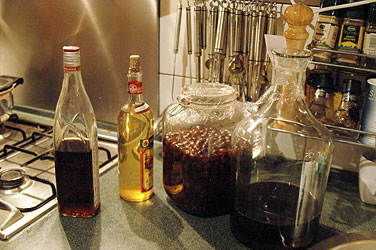
"Contrary to ordinary liqueurs, nalewkas are usually aged. Most of the nalewkas have their proper names derived either from the main ingredient or the name of the traditional place of manufacture. The recipes for nalewkas were at times kept in secret by some of the szlachta families and were only given away to the senior children upon the death of the father." — Nalewka in Wikipedia
Types of Polish nalewka
A whole range of liqueurs made of different ingredients exists.
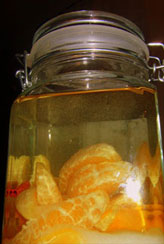
Fruit liqueurs are most popular (morello cherry, apricot, blackberries and the quince liqueur are important examples). Another popular kind is honey liqueurs. Quite specific liqueurs made of spices has following Polish names: 'kardamonka' (cardamom), 'krambambula' (honey + cinnamon + pepper + other spices) or 'imbirowka' (ginger). Herbal liqueurs are also known, as well as other, even more original liqueur as 'kukulka' (made of Polish candies having the same name), or one made from the juice and flowers of the schlock.
How to make nalewka
There's as many recipes for Polish liqueurs as many liqueur exists. Generally speaking fruit liqueurs (most popular) are being prepared by pouring the spirit over fruits. Instead of the spirit one might use vodka - the nalewka will be milder, containing 20-25% of ethanol. During 6 weeks taste, color, essence and nutrients are being extracted from fruits to alcohol. Then we pour this alcoholic extract into another dish, and we add sirup (saturated sugar solution) over the remaining fruits. One must wait a few consecutive weeks, and then the sirup from above the fruits and the alcoholic liqueur are being combined. For emphasizing liqueur's fruit taste, oftentimes a fruit juice and lemon peel are added. Sometimes fruit liqueurs are flavored with vanilla, cardamom, nutmeg, angelica, cloves, cinnamon or the allspice.
Prices in Poland
If you are going to Poland and want to try Polish nalewkas make use of this short information about prices. What I must tell you at first is that probably the most popular, not home-made nalewka you can buy in Poland is Nalewka Babuni. This is a very good product, few tastes are available on the Polish market. Price of a 0.75 L bottle is about 7-8 $, what is quite low making this alcohol affordable for everyone and guaranteeing its popularity.
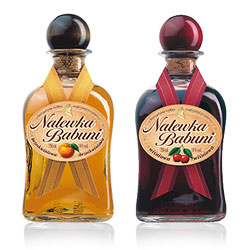

More refined nalewkas are always sold in smaller bottles, just like Nalewka Staropolska which appears in many fruit tastes among which cherry is the most common (see photo). This product costs 13-14 $ per 0.2 L bottle, which is quite a high price. You can find a little bit cheaper, though still refined nalewkas. Those from Kredens company are worth mentioning not only because of a great appearance. Kredens nalewkas cost 7-8$ per 0.2 L bottle. Last but not least - Nalewkas by Z. Kozuba and Synowie are exquisite alcohols sold in art deco style, diamond-like crystal carafes. Cost per 0.7 bottle is about 50 $.
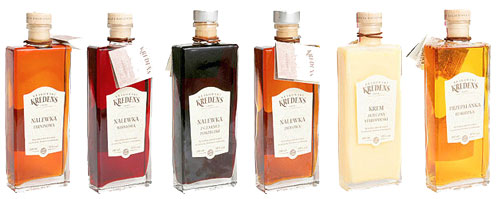
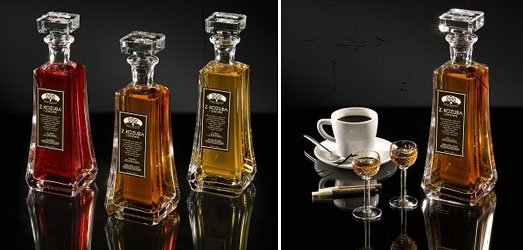
From left: Cranberry Nalewka, Sea-buckthorn Nalewka and Colonial Nalewka.
And here comes some interesting tips & tricks on how to drink nalewka :)
"Remember that in good company unwritten rules pertain as to the drinking of nalevkas. (...) Above all, do not pour the entire contents of the glass into your throat at once! Nalevkas should be drunk in small sips. Furthermore, in order to fully appreciate the taste virtues, consistency and maturity of the drink, it should not be swallowed at once. It should be tasted like good wine, held on the tongue, worked around the palate - that is the task of a true gourmet! Adhering to the aforementioned rules will not only testify to Thine good breeding, but will also bring Thee many wonderful sensations! After a few seconds of such tasting, the nalevka will open before Thee a wealth of hidden tastes, a note of herbs and seasonings, fruit essences and delicate consistency." — from Z. Kozuba i Synowie
Few words about traditions
A number of Old Polish traditions, today no longer cultivated, is connected with fruit liqueurs. Once the fruit liqueurs had been prepared on occasion of christening party of the child, and much later, were opened and drunk only during his/her wedding. On the other hand the so-called 'zenicha kresowa' was liqueur made of rosehips by young girls, who was ready for the marriage. A demijohn with this liqueur was a sign for bachelors, that they can already arrive into the courtship. If a fellow was welcomed favorably, he was given a glass of 'zenicha' by the host.
Liqueurs as the remedy for any ailments
The old folk medicine believed that a lot of nalewkas have a favorable influence on the health and this belief is preserved to this day in some Polish families. For example one might try to treat with the raspberries or juniper liqueur, whether so-called 'orzechowka' (made of nuts), 'sosnowka' (with juice of a pine), or liqueur made from the leaves of the currant. On the other hand the elder liqueur is supposed to cure fever, garlic liqueur (!) will improve your immunity, while problems with the digestive system are most readily solved by liquers made of the mint or anise. The faith in the favorable influence of nalewka was preserved to this day in some Polish families and even though there's no scientific proof, all is know at least is that nalewka always cheers You up.